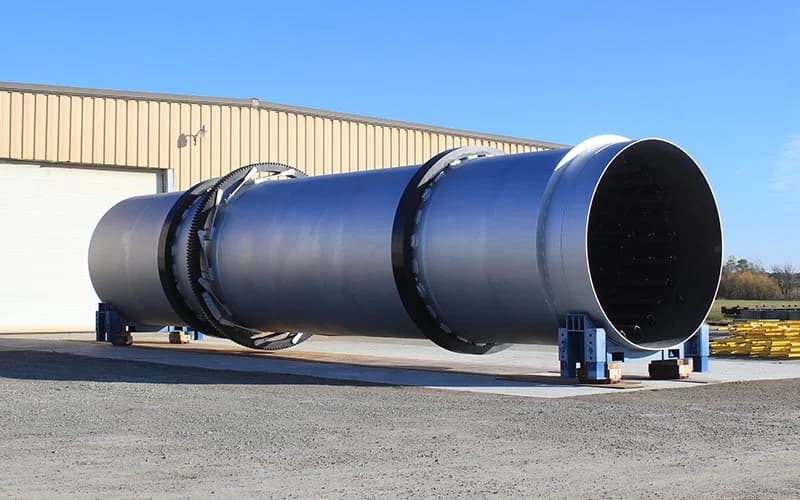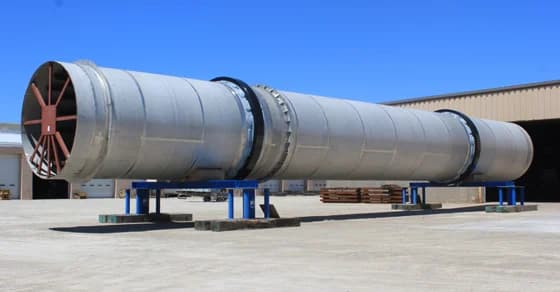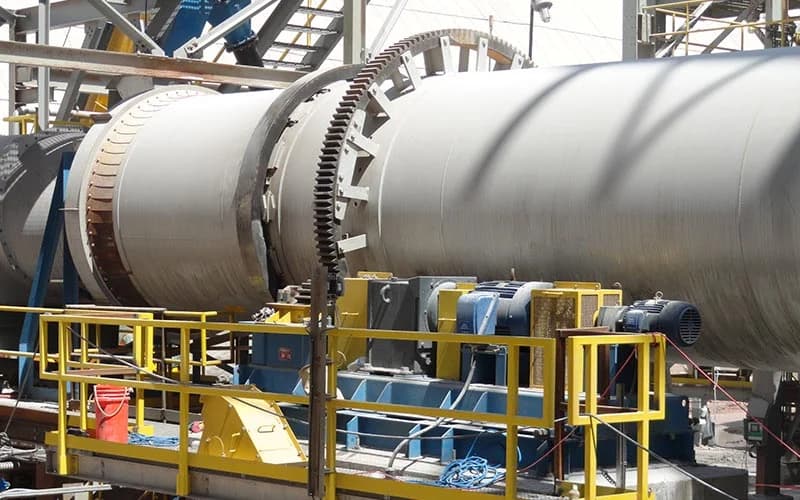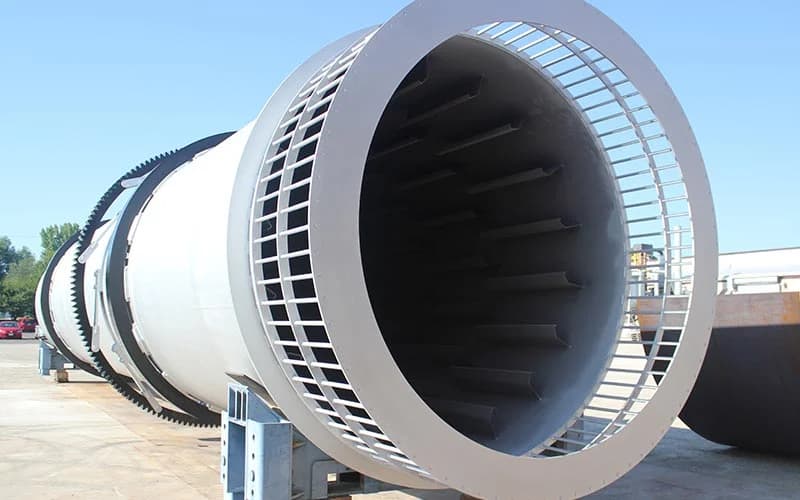Rotary Dryer Parts and Components Glossary
Rotary dryers are essential for many bulk solids handling and processing operations to reduce the moisture content of raw materials and finished products.
About Rotary Dryers
Rotary dryers combine tumbling action and drying air to effectively dry materials. Typically, these large industrial dryers are direct-fired, meaning the drying air is in direct contact with the material. However, some dryers have an indirect configuration where the dryer is externally heated to avoid direct contact between the material and the drying air.
Rotary dryers consist of a rotating drum into which the material is fed along with the drying air. A lifting plate (also known as a platen) picks up the material from the bed, carries it and spills it into the air stream to maximize the heat transfer between the material and the drying air.

The material is processed at a set temperature for a specified period of time (called residence time) to achieve a target moisture content.
While standard models of rotary dryers are available, designing a rotary dryer to meet the unique characteristics of the material and process needs produces the best results and provides the highest level of reliability. All aspects of the dryer are considered during the initial design process to achieve the desired parameters of the final product.
Rotary Dryer Construction
The basic structure of the TONGLI rotary dryer is relatively standard, although the design may be customized to suit the material being processed. Customization is mainly in the areas of dimensions, materials of construction, mechanical components and additional devices. These components are described below.

Cylinders
Rotary dryer cylinders can be made from a variety of materials, including carbon steel, stainless steel, Hastelloy, Inconel, and various other alloys. Cylinders can also be customized in various ways to meet the needs of the material and process. For example, the thickness of the cylinder can be adjusted for conditions where it is important to maintain heat inside the dryer. Cylinders can also be insulated to help retain heat.
The manufacturing process is critical to the cylinder, which must be smooth and concentric in order to function properly. A poorly manufactured drum will increase wear on all components and reduce the efficiency and life of the equipment.
Combustion chamber
The combustion chamber houses the combustion reaction and directs the air flow to the rotary dryer. Combustion chambers can be integrated into downflow (airflow in the same direction as the material flow) or counterflow dryers. The goal of the combustion chamber is to prevent direct material contact with the burner flame. Not all rotary dryers require combustion chambers, but they can provide many benefits.
A wide variety of combustion chambers are available, with customizations ranging from single or double shell to refractory lined and tilting. Combustion chambers can also accommodate a variety of burners. Choosing a high quality combustion chamber is very important to the quality of the product and the energy consumption required for the end product. The use of poor quality combustion chambers can lead to a number of problems ranging from inefficiency to product decomposition and even shortened combustion chamber life in some cases.

Burners
The burner is the engine of any dryer and determines its BTU/Watt output. Burners can be designed to work with a variety of fuel sources, including natural gas, propane, diesel, and more. Selecting the proper burner size is critical to the proper and efficient drying of the material.
Raw Material Feed
The feed zone (also known as the feed chute) is where the material is fed into the system and is usually accomplished by a feed screw conveyor or chute. The feed chute is specially designed to be robust and wear-resistant to minimize material build-up.
Air sealing
Where the combustion chamber and exhaust hood meet the barrel, a seal is required to connect the stationary components to the rotating barrel. The purpose is to prevent air and material from leaving the drum prematurely and, more importantly, to prevent air leakage into the unit reducing process efficiency. Many different sealing options exist depending on the material being processed.
Drive Unit
The drive is the mechanism that rotates the drum. A variety of options are available: chain and sprocket, gear and pinion, friction drive or direct drive units.
Chain and sprocket units are suitable for small rotary drums up to 75 hp, while gear and pinion drives are used for heavier duty applications over 75 hp. Both drive types use a speed reducer to slow down the motor for higher torque.
Friction drives are used for very small and low power drums (typically under 6 feet). In this setup, two of the four support wheels are connected by a shaft and driven by a shaft-mounted reducer and motor unit.
Direct drives are used for small to medium sized drums with motors up to 75 hp. The design consists of a shaft mounted on a solid discharge end plate at the outlet end of the dryer. The motor and reducer are directly connected to this shaft by means of a coupling or shaft mounting device.

Support Ring
The support ring provides structural support for the drum and acts as a pressure absorption point, rolling on the roller wheels.
Thrust Roller
The thrust roller pushes the support ring and prevents the drum from drifting or moving in the longitudinal direction.
Roller Wheel
The roller wheels are the support for the rotating drum shell and ensure smooth and concentric rotation during operation. They also act as wear parts as they are cheaper and easier to replace than support rings. Roller wheels are mounted on a steel support base with sealed roller bearings and carry the weight of the drum.
Lift plates
Available in a variety of designs, the lifting plate or material lifter helps to maximize the efficiency of heat transfer between the material and the drying air. The lifter picks up the material, lifts it up and spills it through the air stream as the drum rotates, promoting efficient heat transfer between the material and the drying air. The design and layout of the lifting plates can be customized.
Product Discharge
The product discharge area is where the product leaves the dryer. Here, the product can move on to the next step in the process. A rotary cooler may follow the dryer to cool the material prior to packaging or storage.
Air Vent
The exhaust vent has two main functions: the product leaves the dryer and enters the screening, cooling, storage or transportation stage, and the exhaust system removes the exhaust gases from the system. The exhaust air system provides an outlet for exhaust gases and hot air (as well as small particles). These exhaust gases and particles typically enter a scrubber or baghouse to remove contaminants before being discharged to the atmosphere.
Common additional equipment
Pusher Lift Plates
Pusher lifting plates help to push material into the drum and prevent buildup near the wet material discharge. Integrating a pusher plate into a rotary dryer also allows the material to dry before it reaches the next plate, a process that helps prevent potential sticking problems.
Knockout Systems
Knockout systems help prevent buildup in the dryer by “knocking out” material as the drum rotates. Knockout systems are available in a variety of options. For more information on knockout systems, please refer to our Knockout Systems brochure.
Tumbler Screens
Tumbler screens (also known as “grizzlies”) can be fitted to rotary dryers to help break up any agglomerates that may form within the dryer.
The selection and design of these components and additional equipment is critical to the performance and efficiency of the rotary dryer. By customizing these elements to the specific application and material characteristics, it is possible to ensure that the rotary dryer achieves optimum drying results and operational reliability.

Conclusion
Rotary dryers are an important part of many industrial applications. They are used to dry a wide range of materials including food, pharmaceuticals, chemicals, minerals and agricultural products. Choosing the right rotary dryer is critical to ensuring product quality and process efficiency.
To learn more about our customized rotary dryer solutions, feel free to contact us! Our team of professionals will provide you with one-on-one consulting services to customize the best solution for you. Through in-depth communication with TONGLI, a professional rotary dryer manufacturer, you can get the customized rotary dryer solution that best suits your needs.

